Architecture in early modern Scotland
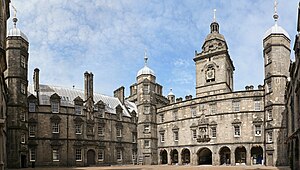
Architecture in early modern Scotlandencompasses all building within the borders of thekingdom of Scotland,from the early sixteenth century to the mid-eighteenth century. The time period roughly corresponds to theearly modern era in Europe,beginning with theRenaissanceandReformationand ending with the start of theEnlightenmentandIndustrialisation.
Vernacular architecturemade use of local materials such as stone, turf and, where available, wood. Most of the population was housed in small hamlets and isolated dwellings. The most common form of dwelling throughout Scotland was thelong house,shared by humans and animals. About ten percent of the population lived in the burghs, in a mixture of half-timbered and stone houses.
The impact of theRenaissanceon Scottish architecture began in the reign ofJames IIIin the late fifteenth century with the rebuilding of royal palaces such asLinlithgow,and reached its peak underJames V.The Reformation had a major impact on ecclesiastical architecture from the mid-sixteenth century onward, resulting in simple church buildings, devoid of ornamentation. From the 1560s great private houses were built in a distinctive style that became known asScottish Baronial.Such houses combined Renaissance features with those of Scottish castles and tower houses, resulting in larger, more comfortable residences.
After theRestorationin 1660, there was a fashion for grand private houses in designs influenced by thePalladianstyle and associated with the architectsSir William Bruce(1630–1710) andJames Smith(c. 1645–1731). After theAct of Union in 1707,the threat ofJacobite Rebellionsled to the building of military defences such asFort Georgenear Inverness. Scotland produced some of the most significant architects of the eighteenth century, includingColen Campbell,James GibbsandWilliam Adam,who all had a major influence onGeorgian architectureacross Britain. The influence of Gibbs led to churches that employed classical elements, with a pedimented rectangular plan and often with a steeple.
Vernacular architecture[edit]

Thevernacular architectureof Scotland, as elsewhere, made use of local materials and methods. The homes of the poor were usually of very simple construction, and were built by groups of family and friends.[1]Stone is plentiful throughout Scotland and was a common building material, employed in both mortared and dry stone construction. As in English vernacular architecture, where wood was available,crucks(pairs of curved timbers) were often used to support the roof. With a lack of long span structural timber, the crucks were sometimes raised and supported on the walls.[2]Walls were often built of stone, and could have gaps filled with turf, or plastered with clay. In some regions wattled walls filled in with turf were employed, sometimes on a stone base.[2]Turf-filled walls were not long-lasting, and had to be rebuilt perhaps as often as every two or three years. In some regions, including the south-west and aroundDundee,solid clay walls were used, or combinations of clay, turf and straw, rendered with clay or lime to make them weatherproof.[3]Different regions used turfs, or thatch of broom, heather, straw or reeds for roofing.[1]
Most of the early modern population, in both the Lowlands and Highlands, was housed in small hamlets and isolated dwellings.[4]As the population expanded, some of these settlements were sub-divided to create new hamlets and more marginal land was settled, withshielings(clusters of huts occupied while summer pasture was being used for grazing), becoming permanent settlements.[5]The standard layout of a house throughout Scotland before agricultural improvement was abyre-dwelling orlong house,with humans and livestock sharing a common roof, often separated by only a partition wall.[6]Contemporaries noted that cottages in theHighlands and Islandstended to be cruder, with single rooms, slit windows and earthen floors, often shared by a large family. In contrast, manyLowlandcottages had distinct rooms and chambers, were clad with plaster or paint and even had glazed windows.[1]
Perhaps ten percent of the population lived in one of manyburghsthat had grown up in the later Medieval period, mainly in the east and south of the country.[7]A characteristic of Scottish burghs was a long main street of tall buildings, withvennels,wyndsandalleysleading off it, many of which survive today.[8]In towns, traditional thatched half-timbered houses were interspersed with the larger stone and slate-roofed town houses of merchants and the urban gentry.[1]Most wooden thatched houses have not survived, but stone houses of the period can be seen in Edinburgh atLady Stair's House,Acheson Houseand the six-storeyGladstone's Land,an early example of the tendency to build upward in the increasingly crowded towns, producing horizontally dividedtenements.[9]Many burghs acquiredtollboothsin this period, which acted as town halls, courts and prisons. They often had peels of bells or clock towers and the aspect of a fortress. TheOld Tolbooth, Edinburghwas rebuilt on the orders ofMary Queen of Scotsfrom 1561 and housed theparliamentuntil the end of the 1630s.[10]Other examples can be seen atTain,CulrossandStonehaven,often showing influences from theLow Countriesin theircrow-stepped gablesand steeples.[11]
Renaissance[edit]

The extensive building and rebuilding of royal palaces probably began underJames III(r. 1460–88), accelerated underJames IV(r. 1488–1513) and reached its peak underJames V(r. 1513–42). The influence of Renaissance architecture is reflected in these buildings.Linlithgowwas first constructed underJames I(r. 1406–27), under the direction ofmaster of workJohn de Waltoun and was referred to as a palace from 1429, apparently the first use of this term in the country. It was extended under James III and resembled a quadrangular, corner-towered Italian signorial palace orpalatium ad moden castri(a castle-style palace), combining classical symmetry with neo-chivalric imagery. There is evidence that Italian masons were employed by James IV, in whose reign Linlithgow was completed and other palaces were rebuilt with Italianate proportions.[12]
In 1536 James V visited France for his marriage toMadeleine of Valoisand would have come in contact withFrench Renaissance architecture.His second marriage toMary of Guisetwo years later may have resulted in longer-term connections and influences.[13]Architecture from his reign largely disregarded the insular style of England underHenry VIIIand adopted forms that were recognisably European.[14]Rather than slavishly copying continental forms, most Scottish architecture incorporated elements of these styles into traditional local patterns,[15]adapting them to Scottish idioms and materials (particularly stone andharl).[16]Some decorative wood carvings were made by French craftsmen, who likeAndrew Mansioun,settled in Scotland.[17]The building at Linlithgow was followed by rebuilding atHolyrood Palace,Falkland Palace,Stirling CastleandEdinburgh Castle,[15]described by Roger Mason as "some of the finest examples of Renaissance architecture in Britain".[18]
Many of the building programs were planned and financed byJames Hamilton of Finnart,Steward of the Royal HouseholdandMaster of Worksto James V. He was also responsible for the architectural works atBlackness Castle,Rothesay Castle,the house atCrawfordjohn,the New Inn in theSt Andrews Cathedral Prioryand the lodging atBalmerino Abbeyfor the ailing Queen Madeleine.[19]For the six years of her regencyMary of Guiseemployed an Italian military architect, Lorenzo Pomarelli.[20]Work undertaken for James VI demonstrated continued Renaissance influences; the Chapel Royal at Stirling has a classical entrance built in 1594 and the North Wing of Linlithgow, built in 1618, uses classical pediments. Similar themes can be seen in the private houses of aristocrats, as inMar's Wark,Stirling (c. 1570) andCrichton Castle,built for theEarl of Bothwellin 1580s.[21]
Reformation[edit]
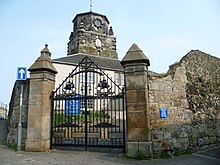
From about 1560, the Reformation revolutionised church architecture in Scotland. Calvinists rejected ornamentation in places of worship, seeing no need for elaborate buildings divided up for the purpose of ritual. This resulted in the widespread destruction of Medieval church furnishings, ornaments and decoration.[22]New churches were built and existent churches adapted for reformed services, particularly by placing the pulpit centrally in the church, as preaching was at the centre of worship. Many of the earliest buildings were simple gabled rectangles, a style that continued into the seventeenth century, as atDunnottar Castlein the 1580s,Greenock(1591) andDurness(1619).[23]These churches often have windows on the south wall (and none on the north), which became a characteristic of Reformation kirks. There were continuities with pre-Reformation materials, with some churches using rubble for walls, as atKembackin Fife (1582). Others employed dressed stone and a few added wooden steeples, as atBurntisland(1592).[24]The church ofGreyfriars, Edinburgh,built between 1602 and 1620, used a rectangular layout with a largely Gothic form, but that atDirleton(1612), had a more sophisticated classical style.[23]
A variation of the rectangular church developed in post-Reformation Scotland, and often used when adapting existing churches, was the T-shaped plan, which allowed the maximum number of parishioners to be near the pulpit. Examples can be seen at Kemback andPrestonpansafter 1595. This plan continued to be used into the seventeenth century as atWeem(1600),Anstruther Easter,Fife (1634–44) andNew Cumnock(1657). In the seventeenth century aGreek crossplan was used for churches such asCawdor(1619) andFenwick(1643). In most of these cases one arm of the cross would have been closed off as a laird's aisle, meaning that they were in effect T-plan churches.[23]
Scots Baronial[edit]

The unique style of great private houses in Scotland, later known as Scots Baronial, originated in the 1560s and may have been influenced by the French masons brought to Scotland to work on royal palaces. It kept many of the features of the high walled Medieval castles that had been largely made obsolete by gunpowder weapons and also drew on thetower housesandpeel towers[25]that had been built in their hundreds by local lords since the fourteenth century, particularly in the borders. These houses abandoned the defensible curtain walls of castles, being fortified refuges that were designed to outlast a raid, rather than a sustained siege.[26][27]They were usually of three stories, typically crowned with aparapet,projecting oncorbels,continuing into circularbartizansat each corner.[28]The new houses built from the late sixteenth century by nobles andlairdswere primarily designed for comfort, not for defence. They retained many of the external features that had become associated with nobility but with a larger ground plan, classically a "Z-plan" of a rectangular block with towers, as atColliston Castle(1583) andClaypotts Castle(1569–88).[25]
William Wallace,the king's master mason from 1617 until his death in 1631, was particularly influential. He worked on the rebuilding of the collapsed North Range of Linlithgow from 1618,Winton HouseforGeorge Seton, 3rd Earl of Winton,Moray Housefor theCountess of Home,and began work onHeriot's Hospital,Edinburgh. He adopted a distinctive style that applied elements of Scottish fortification and Flemish influences to a Renaissance plan similar to that used atChâteau d'Ancy-le-Franc.This style can be seen in lords' houses built atCaerlaverlock(1620),Moray House,Edinburgh (1628) andDrumlanrig Castle(1675–89), and was highly influential until the Baronial style gave way to the grander English forms associated withInigo Jonesin the later seventeenth century.[25]
Commonwealth and Restoration[edit]
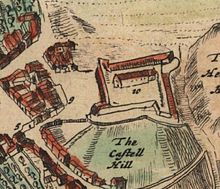
During the turbulent era of theCivil Warsand the incorporation of Scotland into aCommonwealth of England, Scotland and Ireland,significant building in Scotland was largely confined to military architecture. Polygonal fortresses with triangular bastions in the style of thetrace italiennewere built to house English soldiers atAyr,PerthandLeith,and 20 smaller forts were built as far apart asOrkneyandStornoway.Control of the Highlands was secured by new strongpoints atInverlockyandInverness.[29]The universities saw an improvement in their funding, as they were given income from deaneries, defunct bishoprics and the excise, allowing the completion of buildings including the college in theHigh Streetin Glasgow.[30]After theRestorationin 1660, large-scale building began again, influenced by a growing interest inClassicism.[29]
Palaces and estate houses[edit]

Sir William Bruce(c. 1630–1710) is considered "the effective founder ofclassical architecturein Scotland "and was the key figure in introducing thePalladian styleto the country.Andrea Palladio(1508–80) was an influential architect who worked in the region ofVenicein the sixteenth century and whose buildings are characterised by symmetry, fine proportion and formal elements drawn fromAncient Classical architecture.In England the introduction of the Palladian style is associated withInigo Jones(1573–1652). Bruce's architectural style incorporated Palladian elements and was influenced by Jones, but also borrowed from theItalian Baroqueand was most strongly influenced by SirChristopher Wren's (1632–1723) interpretation of theBaroquein England.[31]Bruce popularised a style of country house among the Scottish nobility that encouraged a move towards a more leisure-oriented architecture already adopted in continental Europe.[32]He built and remodelled country houses, includingThirlestane CastleandPrestonfield House.[33]Among his most significant work was his own Palladian mansion atKinross,built on the Loch Leven estate he had purchased in 1675.[33]Bruce's houses were predominantly built using well-cutashlarmasonry on the façades; rubble stonework was used only for internal walls.[34]As theSurveyor and Overseer of the Royal WorksBruce undertook the rebuilding of the Royal Palace ofHolyroodhousein the 1670s, giving the palace its present appearance.[32]After the death ofCharles IIin 1685, Bruce lost political favour, and following theGlorious Revolutionof 1688 he was imprisoned more than once as a suspectedJacobite.[35]
James Smith(c. 1645–1731) worked as a mason on Bruce's rebuilding of Holyrood Palace. In 1683 he was appointed Surveyor and Overseer of the Royal Works, responsible for the palace's maintenance. With his father-in-law, the master masonRobert Mylne(1633–1710), Smith worked onCaroline ParkinEdinburgh(1685), andDrumlanrig Castle(1680s). Smith's country houses followed the pattern established by William Bruce, with hipped roofs and pedimented fronts, in a plain but handsome Palladian style.[32]Hamilton Palace(1695) was fronted by giantCorinthiancolumns, and a pedimented entrance, but was otherwise restrained.Dalkeith Palace(1702–10) was modelled afterWilliam of Orange's palace atHet Looin the Netherlands.[36]
Churches[edit]

By the later seventeenth century both thePresbyterianandEpiscopalianwings of thechurchhad adopted the modestly sized and plain form of churches that had emerged after the Reformation.[37]Most had a centralised plan with two or three arms, in a rectangular or T-planned arrangement. Steeples continued to be a major feature, either centrally on the long axis, or on an end gable, as had been the case in pre-Reformation churches.[37]As a result, there was little of theBaroqueextravagance in church building seen on the continent and England.[36]Some minor innovations may indicate a move back toward episcopacy in the Restoration era.Lauder Churchwas built by Bruce in 1673 for theDuke of Lauderdale,who championed the bishops in the reign ofCharles II.The Gothic windows may have emphasised antiquity, but its basic Greek cross plan remained within the existing common framework of new churches.[37]
The major exceptions to the common Greek cross plan are in the work of Smith, who had become aJesuitin his youth.[38]These included the rebuilding ofHolyrood Abbeyundertaken forJames VIIin 1687, which was outfitted in an elaborate style. In 1691 Smith designed the mausoleum of SirGeorge Mackenzie of Rosehaugh,inGreyfriars Kirkyard,a circular structure modelled on the Tempietto di San Pietro, designed byDonato Bramante(1444–1514).[36]The drive to Episcopalian forms of worship may have resulted in more linear patterns, including rectangular plans with the pulpit at the end opposite the entrance. TheLatin Crossform increasingly popular inCounter ReformationCatholicism, was also used, as in Smith'sCanongate Kirk(1688–90), but the Presbyterian revolution of 1689–90 occurred before its completion and the chancel was blocked up, effectively transforming it into a T-plan.[38]
Early eighteenth century[edit]
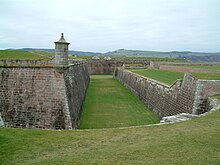
After theAct of Union of 1707,growing prosperity in Scotland led to a spate of new building, both public and private. The threat ofJacobiteinsurrection or invasion meant that Scotland saw more military building than England in this period. Military structures relied on the strength of inclined and angled engineered masonry and earthen toppings to deflect and absorb artillery fire. This spate of military building culminated in the construction ofFort Georgenear Inverness (1748–69), with its projectingbastionsandredoubts.[34]
Country houses[edit]
Scotland produced some of the most significant architects of the early eighteenth century, includingColen Campbell(1676–1729),James Gibbs(1682–1754) andWilliam Adam(1689–1748), all of whom were influenced by Classical architecture. Campbell was influenced by the Palladian style and has been credited with founding Georgian architecture. Architectural historianHoward Colvinhas speculated that he was associated with James Smith and may even have been his pupil.[32]He spent most of his career in Italy and England and developed a rivalry with fellow Scot James Gibbs, who trained in Rome and also practised mainly in England. Campbell's architectural style incorporated Palladian elements, as well as forms from the Italian Baroque and Inigo Jones, but was most strongly influenced by Sir Christopher Wren's interpretation of the Baroque.[31]William Adam,the foremost Scottish architect of his time,[39][40]designed and built numerous country houses and public buildings. Among his best known works areHopetoun Housenear Edinburgh, andDuff HouseinBanff.His individual, exuberant, style was built on the Palladian style, but withBaroquemotifs inspired by the work ofJohn Vanbrughand Continental architecture. After his death, his sons Robert and John took on the family business and became the leading British architects of the second half of the century.[41]
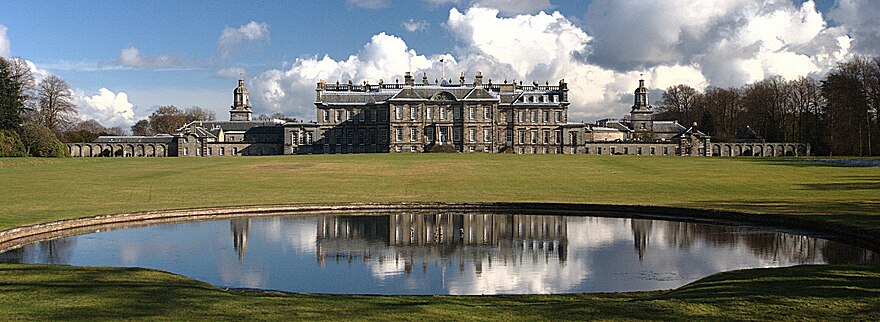
Neo-classical churches[edit]

In the eighteenth century established patterns of church building continued, with T-shaped plans with steeples on the long side, as at New Church,Dumfries(1724–27), andNewbattleParish Church (1727–29).William Adam'sHamiltonParish Church (1729–32), was a Greek cross plan inscribed in a circle, while John Douglas'sKillinChurch (1744) was octagonal. Scots-born architectJames Gibbswas highly influential on British ecclesiastical architecture. He introduced a consciously antique style in his rebuilding ofSt Martin-in-the-Fields,London, with a massive, steepledporticoand rectangular, side-aisled plan. Similar patterns in Scotland can be seen atSt Andrew's in the Square(1737–59), designed by Allan Dreghorn and built by the master mason Mungo Nasmyth, and at the smallerDonibristleChapel (completed in 1731), designed byAlexander McGill.Gibbs' own design for St. Nicholas West, Aberdeen (1752–55), had the same rectangular plan, with a nave-and-aisles, barrel-vaulted layout with superimposed pedimented front.[38]After the Toleration Act of 1712, Episcopalians began building a limited number of new chapels including Alexander Jaffray's St Paul's chapel in Aberdeen (1721), the meeting house designed by McGill in Montrose, an Edinburgh chapel opened in 1722 andSt Andrew's-by-the-Greenin Glasgow (1750–52), which adopted a simpler version of Gibbs' pedimented rectangular plan.[42]
See also[edit]
- Architecture of Scotland
- Architecture in Medieval Scotland
- Architecture in modern Scotland
- Domestic furnishing in early modern Scotland
Notes[edit]
- ^abcdC. McKean, "Improvement and modernisation in everyday Enlightenment Scotland", in E. A. Foyster and C. A. Whatley, ed.,A History of Everyday Life in Scotland, 1600 to 1800(Edinburgh: Edinburgh University Press, 2010),ISBN0-7486-1965-8,pp. 55–56.
- ^abP. Dixon, "The medieval peasant building in Scotland: the beginning and end of crucks",Ruralia IV(2003), pp. 187–200, available atAcademia.edu,retrieved 27 March 2013.
- ^R. W. Brunskill,Houses and Cottages of Britain(New Haven, Connecticut: Yale University Press, 2nd edn., 2000),ISBN0-575-07122-2,pp. 235–40.
- ^I. D. Whyte and K. A. Whyte,The Changing Scottish Landscape: 1500–1800(London: Taylor & Francis, 1991),ISBN0415029929,p. 5.
- ^I. D. Whyte and K. A. Whyte,The Changing Scottish Landscape: 1500–1800(London: Taylor & Francis, 1991),ISBN0415029929,pp. 18–19.
- ^I. Whyte and K. A. Whyte,The Changing Scottish Landscape: 1500–1800(London: Taylor & Francis, 1991),ISBN0-415-02992-9,p. 35.
- ^E. Gemmill and N. J. Mayhew,Changing Values in Medieval Scotland: a Study of Prices, Money, and Weights and Measures(Cambridge: Cambridge University Press, 1995),ISBN0521473853,pp. 8–10.
- ^R. Mitchison,Lordship to Patronage, Scotland 1603–1745(Edinburgh: Edinburgh University Press, 1983),ISBN0-7486-0233-X,pp. 99–100.
- ^T. W. West,Discovering Scottish Architecture(Botley: Osprey, 1985),ISBN0-85263-748-9,pp. 75–76.
- ^R. A. Mason,Scots and Britons: Scottish Political Thought and the Union of 1603(Cambridge: Cambridge University Press, 2006),ISBN0521026202,p. 82.
- ^T. W. West,Discovering Scottish Architecture(Botley: Osprey, 1985),ISBN0-85263-748-9,pp. 73–74.
- ^M. Glendinning, R. MacInnes and A. MacKechnie,A History of Scottish Architecture: From the Renaissance to the Present Day(Edinburgh: Edinburgh University Press, 1996),ISBN0-7486-0849-4,p. 9.
- ^A. Thomas,The Renaissance,in T. M. Devine and J. Wormald, eds,The Oxford Handbook of Modern Scottish History(Oxford: Oxford University Press, 2012),ISBN0-19-162433-0,p. 195.
- ^J. Wormald,Court, Kirk, and Community: Scotland, 1470–1625(Edinburgh: Edinburgh University Press, 1991),ISBN0-7486-0276-3,p. 5.
- ^abA. Thomas, "The Renaissance", in T. M. Devine and J. Wormald, eds,The Oxford Handbook of Modern Scottish History(Oxford: Oxford University Press, 2012),ISBN0-19-162433-0,p. 189.
- ^D. M. Palliser,The Cambridge Urban History of Britain: 600–1540, Volume 1(Cambridge: Cambridge University Press, 2000),ISBN0-521-44461-6,pp. 391–2.
- ^Michael Pearce, 'A French Furniture Maker and the 'Courtly Style' in Sixteenth-Century Scotland',Regional Furniturevol. XXXII (2018), pp. 127-36.
- ^R. Mason, "Renaissance and Reformation: the sixteenth century", in J. Wormald, ed.,Scotland: A History(Oxford: Oxford University Press, 2005),ISBN0-19-162243-5,p. 102.
- ^J. E. A. Dawson,Scotland Re-Formed, 1488–1587(Edinburgh: Edinburgh University Press, 2007),ISBN0-7486-1455-9,p. 120.
- ^Amadio Ronchini, 'Lorenzo Pomarelli' inAtti e memorie delle RR. Deputazioni di storia patria per le provincie Modenesi e Parmensi(Modena, 1868), pp. 264-5, 271.
- ^A. Thomas, "The Renaissance", in T. M. Devine and J. Wormald, eds,The Oxford Handbook of Modern Scottish History(Oxford: Oxford University Press, 2012),ISBN0-19-162433-0,pp. 201–2.
- ^Royal Institute of British Architects,Kirks throughout the ages,architecture.com, archived fromthe originalon 14 October 2007,retrieved13 January2010
- ^abcA. Spicer, "Architecture", in A. Pettegree, ed.,The Reformation World(London: Routledge, 2000),ISBN0-415-16357-9,p. 517.
- ^A. Spicer,Calvinist Churches in Early Modern Europe(Manchester: Manchester University Press, 2007),ISBN0-7190-5487-7,pp. 53 and 57.
- ^abcJ. Summerson,Architecture in Britain, 1530 to 1830(New Haven, Connecticut: Yale University Press, 9th edn., 1993),ISBN0-300-05886-1,pp. 502–11.
- ^S. Toy,Castles: Their Construction and History(New York: Dover Publications, 1985),ISBN978-0-486-24898-1,p. 224.
- ^S. Reid,Castles and Tower Houses of the Scottish Clans, 1450–1650(Botley: Osprey, 2006),ISBN978-1-84176-962-2,p. 33.
- ^J. Summerson,Architecture in Britain, 1530 to 1830(New Haven, Connecticut: Yale University Press, 9th edn., 1993),ISBN0-300-05886-1,p. 502.
- ^abM. Glendinning, R. MacInnes and A. MacKechnie,A History of Scottish Architecture: from the Renaissance to the Present Day(Edinburgh: Edinburgh University Press, 2002),ISBN978-0-7486-0849-2,p. 70.
- ^J. D. Mackie, B. Lenman and G. Parker,A History of Scotland(London: Penguin, 1991),ISBN0140136495,pp. 227–8.
- ^abJ. Summerson,Architecture of Britain, 1530–1830(New Haven, Connecticut: Yale University Press, 9th edition, 1993),ISBN0-300-05886-1,pp. 330 and 333.
- ^abcdH. Colvin,A Biographical Dictionary of British Architects, 1600–1840(New Haven/London: Yale University Press, 1995), pp. 755–8.
- ^abJ. Gifford,William Adam 1689–1748(Edinburgh: Mainstream Publishing/RIAS, 1989),ISBN1-85158-295-9,pp. 57–58.
- ^abI. Maxwell,A History of Scotland's Masonry Constructionin P. Wilson, ed.,Building with Scottish Stone(Edinburgh: Arcamedia, 2005),ISBN1-904320-02-3,p. 26.
- ^H. Fenwick,Architect Royal: the Life and Work of Sir William Bruce(Kineton: Roundwood Press, 1970),ISBN0-8390-0156-8,pp. 73–8.
- ^abcJ. Gifford,William Adam 1689–1748(Edinburgh: Mainstream Publishing/RIAS, 1989),ISBN1-85158-295-9,pp. 62–7.
- ^abcM. Glendinning, R. MacInnes and A. MacKechnie,A History of Scottish Architecture: From the Renaissance to the Present Day(Edinburgh: Edinburgh University Press, 1996),ISBN0-7486-0849-4,p. 141.
- ^abcM. Glendinning, R. MacInnes and A. MacKechnie,A History of Scottish Architecture: From the Renaissance to the Present Day(Edinburgh: Edinburgh University Press, 1996),ISBN0-7486-0849-4,p. 143.
- ^C. McWilliam,The Buildings of Scotland: Lothian (except Edinburgh)(London: Penguin, 1978), p. 57.
- ^M. Glendinning, A. McKechnie, R. McInnesBuilding a Nation: The Story of Scotland's Architecture(Canongate, 1999),ISBN0-86241-830-5,p. 48.
- ^N. Pevsner,An Outline of European Architecture(London: Pelican, 2nd edition, 1951), p. 237.
- ^M. Glendinning, R. MacInnes and A. MacKechnie,A History of Scottish Architecture: From the Renaissance to the Present Day(Edinburgh: Edinburgh University Press, 1996),ISBN0-7486-0849-4,p. 143-4.
